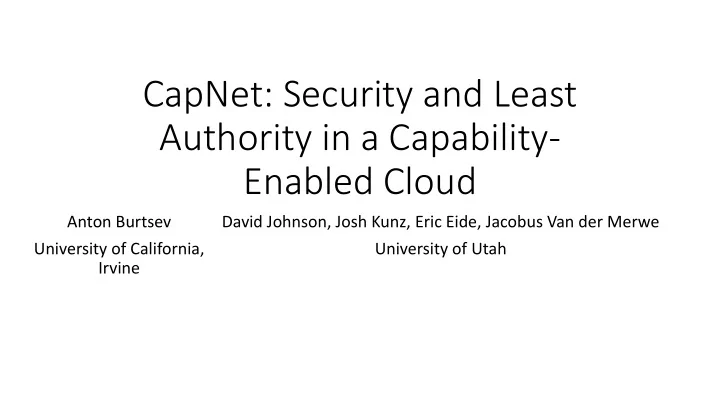

CapNet: Security and Least Authority in a Capability- Enabled Cloud Anton Burtsev David Johnson, Josh Kunz, Eric Eide, Jacobus Van der Merwe University of California, University of Utah Irvine
Modern clouds are vulnerable
Step 1: End-device
Endpoints are inherently vulnerable Linux Kernel Vulnerabilities by Year 400 350 300 250 200 150 100 50 0 2009 2010 2011 2012 2013 2014 2015 2016 2017
Step 2: cloud network Cloud network is the main attack amplifier
Legacy network-isolation primitives • Global tenant-wide access control rules • E.g., security groups • Lack of mutual isolation • Lack of decentralized access control • Need to trust a third party
Capability-enabled network
CapNet Architecture
Threat model • We trust • Cloud provider infrastructure • Network switches • SDN controller • Hypervisors • Cloud software stack • Hosts are malicious • Virtual and physical hosts on the network • Providers of third-party cloud services
CapNet Architecture • Software defined network (SDN) • CapNet runs as an SDN controller application • Tracks resources of the network • By default nodes are completely isolated • No flows are allowed
Objects and capabilities
CapNet Architecture • On the host, capabilities are just 64-bit numbers • Have no meaning outside of the host • Capabilities are resolved through Node’s CSpace into pointers to other objects • CapNet associates a Node object with each host on the network • Unique {switch, port} pair
Objects CapNet Capability graph Physical resources
Nodes • Node is "born" with one special capability, rp0 , connecting it to creator
RendezvousPoints • RendezvousPoints allow Nodes exchange capabilities • Capability derivation trees (CDT)
Flows • A unidirectional communication channel • The ability to send packets to a particular network endpoint
Grant i nvoke ( c a p c , m e t hod m , a r gs ) gr a nt . gr a nt ( c a p c ) • Grant allows a node to operate on behalf of another node • i.e., create objects on its behalf, enable network connections • Support for legacy capability-oblivious hosts
Grant i nvoke ( c a p c , m , a r gs ) gr a nt . gr a nt ( c a p c ) gr a nt . t a ke ( c a pa bi l i t y_i d c a p_i d)
Grant i nvoke ( c a p c , m , a r gs ) gr a nt . gr a nt ( c a p c ) gr a nt . t a ke ( c a pa bi l i t y_i d c a p_i d) gr a nt . c r e a t e ( Fl ow)
Convenient network programming • Example: connecting two nodes A and B 1. connect (cap gantA, cap grantB) 2. flowA = grantA.create(Flow) 3. flowB = grantB.create(Flow) 4. grantA.grant(flowB) 5. grantA.grant(flowA)
Decentralized Authority and Collaboration
Reset operation • Reset the node to a clean, isolated state irrespective of its prior state and ownership
Reset operation: internals • Tracking and cleaning authority of the node
Reset preserves ownership
Membranes: recursive isolation of capability graphs
Membranes
Membranes
Membranes
SealersUnsealers FAIL!
In CapNet SealersUnsealers go through membranes unlabeled
Protocols of Secure Collaboration
Secure provider protocol
Recursion
Trees and general graphs • Membranes and reset allow the construction of trees in capability graphs
Trees and general graphs • SealerUnsealer enable cloud topologies that are general graphs
Joint computation protocol
CapNet in OpenStack
Thank you! Anton Burtsev aburtsev@uci.edu Paper: SoCC’17 Source: https://gitlab.flux.utah.edu/tcloud/capnet Test drive in CloudLab: https://www.cloudlab.us/p/TCloud/OpenStack-Capnet
Endpoint
Recursive isolation of capability graphs
CapNet Objects Physical resources • Node – hosts on the network • RendezvousPoint – exchange of capabilities • Flow – network flows Capability graph • Grant – support for unmodified hosts • Membrane – transitive isolation of capability graphs • SealerUnsealer – secure transport of capabilities
Recommend
More recommend